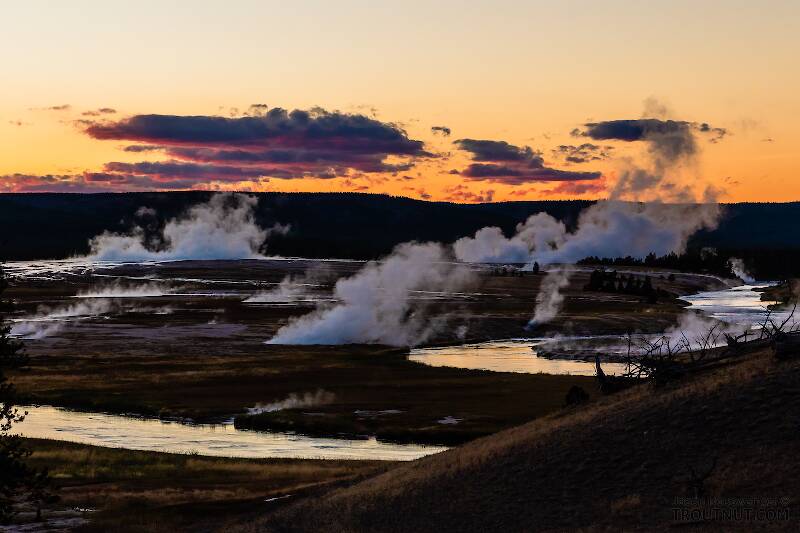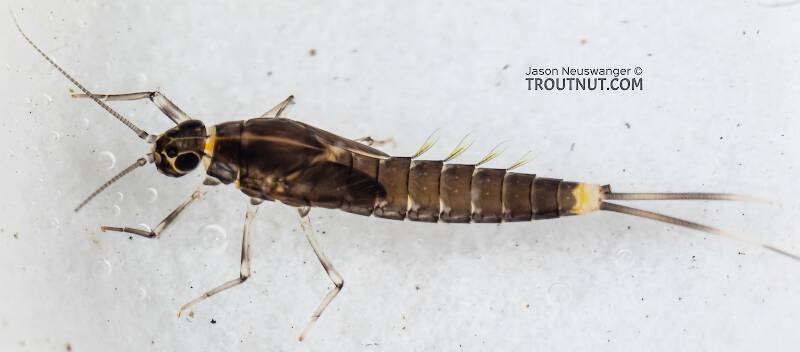
Hex Mayflies
Hexagenia limbata
The famous nocturnal Hex hatch of the Midwest (and a few other lucky locations) stirs to the surface mythically large brown trout that only touch streamers for the rest of the year.

Mayfly Species Diphetor hageni (Little Blue-Winged Olives)
Taxonomic History
Where & when
Time of year : April and May, then another brood in September and October; sometimes another intermediate brood
Preferred waters: Fertile streams
In 14 records from GBIF, adults of this species have been collected during June (29%), April (29%), July (14%), August (14%), December (7%), and May (7%).
In 8 records from GBIF, this species has been collected at elevations ranging from 700 to 8871 ft, with an average (median) of 5420 ft.
Species Range
Hatching behavior
The nymphs and duns are both important during this hatch.Spinner behavior
Fred Arbona in Mayflies, the Angler, and the Trout describes peculiar spinner behavior in this species:Spinners gather in the mornings or evenings, and their tight swarms can be observed over the banks of the stream. After mating, the spinners suddenly vanish and reappear spent on the water.
Nymph biology
These nymphs are very versatile: cold or warm water, slow or fast water, spring creeks and freestone streams.Identification
Dorsal abdominal markings on the nymphs used to differentiate the species in these older publications have since proved unreliable. The easiest way to tell them apart from B. tricaudatus is their lack of gills on the first abdominal segment. Telling adults apart is equally tough. Duns of D. hageni are typically a little smaller, but their bodies can also be olive, brownish olive and even two toned with thoraxes a shade of brown or tan with paler olivacious abdomens.Physical description
Most physical descriptions on Troutnut are direct or slightly edited quotes from the original scientific sources describing or updating the species, although there may be errors in copying them to this website. Such descriptions aren't always definitive, because species often turn out to be more variable than the original describers observed. In some cases, only a single specimen was described! However, they are useful starting points.
Male Spinner
Wing length: 5-5.5 mm
Abdominal tergites 2-6 of male imago hyaline whitish; genitalia of the Baetis intercalaris type, tubercle present on inner margin of basal forceps joint. Second vein of hind wing forked near base.
Head and antennae light red-brown. Turbinate eyes moderate in size; stalk yellowish, upper surface pale orange in alcoholic specimens. Thoracic notum rather dark reddish brown; margins of scutellum blackish. Pleura and sternum somewhat paler red-brown; intersegmental areas of pleura yellowish. Legs whitish; fore femora yellowish, other femora faintly yellow-tinged; coxae reddish brown. Wings hyaline, venation pale. A faint cloud in the stigmatic area of the fore wing; cross veins 6-8 in number; aslant, no apparent tendency to fork, sometimes incomplete toward the subcosta; between them, many granulations. Marginal intercalaries much as in B. parvus (now a synonym of Diphetor hageni). Hind wing very similar to that of parvus (see fig. 163).)
Basal segment of abdomen dark reddish brown dorsally, paler ventrally. Abdominal segments 2-6 hyaline, white. Spiracles outlined in black; geminate blackish tracings along the entire spiracular area; on the basal sternites especially, short oblique branches extend out from the main spiracular line. Segments 7-10 light reddish brown, opaque; sternites slightly paler than tergites; posterior margins of tergites and sternites darker red-brown, presenting an annulate appearance. Tails and forceps white. At the inner apical margin of the basal forceps joint is a distinct tubercle or inward projection; inner margin of this joint somewhat irregular. Apical joint of forceps relatively shorter than in parvus, being about one-third the length of the penultimate one (see fig. 164).
Described as B. parvus
Body length 5.5 mm, wing length 5-5.5 mm
Abdominal tergites 2-6 of male imago hyaline, whitish, unmarked; genitalia of the Baetis intercalaris type, no tubercle on inner apical margin of first forceps joint. Second vein of hind wing forked near base.
Head and thorax deep blackish brown; filament of antenna paler. Turbinate eyes moderate in size; both stalk and upper surface dark orange brown, in dried specimens. Paler red-brown areas on pleura below the wings; tip of scutellum paler brown. Legs whitish. Wings hyaline, venation pale. 5-8 cross veins in the stigmatic area of the fore wing, often with short horizontal veins between them, aslant, often incomplete on the subcostal margin, sometimes forking toward the subcosta. Usually one short intercalary in the first interspace; those of the second interspace slightly shorter than the following pairs. Hind wing unusually wide for its length; costal projection well developed. Three longitudinal veins, the second forked near the base; one long intercalary in this fork (usually also a pair of short intercalaries just below the anterior branch, not shown in Dr. Dodds’ sketch; traces of another short one between the long intercalary and the posterior branch, in some specimens).
Basal tergite of abdomen wholly dark brown, sternite somewhat paler. Abdominal segments 2-6 hyaline white; usually no dark spiracular markings. Tergites 7-10 opaque, brown; wholly or in part suffused with deep rose-color. Sternites opaque creamy white, more or less shaded and marked with rose. Tails white. No tubercle or projection on the inner apical margin of the basal forceps joint. Apical joint of forceps fully half as long as the penultimate one.
The forked second vein of the hind wing distinguishes this species from all other described North American species excepting B. devinctus (now a synonym of Diphetor hageni); the presence of a well-developed tubercle on the inner margin of the basal forceps joint, as well as the paler thorax, separates devinctus from parvus.
Female Spinner
Wing length: 5 mm
Specimens of the Mayfly Species Diphetor hageni
1 Nymph
Start a Discussion of Diphetor hageni
References
- Arbona, Fred Jr. 1989. Mayflies, the Angler, and the Trout. Nick Lyons Books.
- Caucci, Al and Nastasi, Bob. 2004. Hatches II. The Lyons Press.
- Knopp, Malcolm and Robert Cormier. 1997. Mayflies: An Angler's Study of Trout Water Ephemeroptera . The Lyons Press.
- Needham, James G., Jay R. Traver, and Yin-Chi Hsu. 1935. The Biology of Mayflies. Comstock Publishing Company, Inc.
Mayfly Species Diphetor hageni (Little Blue-Winged Olives)
Species Range
Common Names
Resources
- NatureServe
- Integrated Taxonomic Information System
- Global Biodiversity Information Facility
- Described by Eaton (1885)



